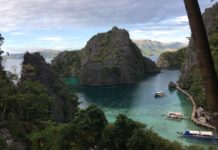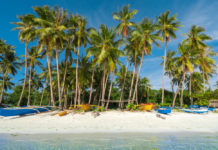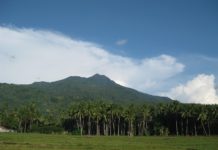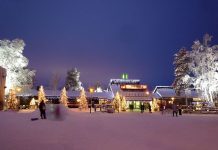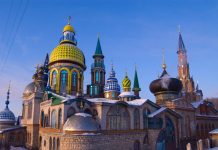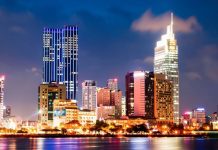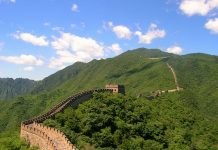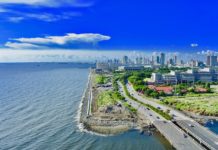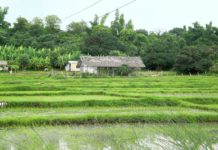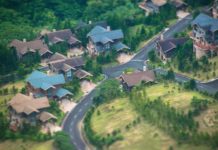Manila is the crazy capital of the Philippines.
And if you’re thinking of going there… Then cool! You can expect to see frenetic city streets, big public parks, remnants of the Spanish colonial times and a whole bunch of malls, cool neighbourhoods and local joints to eat at.
But Manila is far from perfect.
There is a problem with petty crime, there’s some really bad pollution here and the public transport is not exactly great. So if you are wondering if Manila is safe… You’ve come to the right place.
We have created a guide to how to stay safe in Manila, filling it with all the information and tips you need for a smooth, secure trip to the Philippines’ capital city.

How Safe is Manila? (Our take)
Manila, or Metro Manila, spans an absolutely huge area.
So when you say “Manila,” you might mean the centre of town, or you may mean one of the many cities that make up the metropolitan area, such as Quezon City, Pasay or Makati City.
Because it’s such a huge area, naturally there are going to be some issues.
At the same time, also because it’s such a big place, the same issues that affect one part of Manila aren’t going to affect another place.
However, one thing that you will more than likely come face to face with on a trip to Manila is poverty.
Despite having a reputation as being one of the most dangerous cities in Southeast Asia, the likelihood of actually coming into contact with a dangerous situation is very low. There are pickpockets, and some areas don’t have a good atmosphere, but as long as you are cautious – especially in areas where crime rates are high – we think you should be fine!
Is Manila Safe to Visit? (The facts.)

Statistics are one part of what actually makes people think that Manila is unsafe to visit. The high crime rate, for instance, is all stats.
On the other hand, how many people are actually going to this “unsafe” city? What makes the Philippines tick? What are those crime figures?
Let’s take a look…
- Tourism in the Philippines, in general, is on the rise. In 2018, the country received 7.1 million (7.8% more than the previous year).
- The highest number of tourists are from South Korea, followed by China and then the U.S.
- The Philippines has a population of 88.57 million – the 12th most populous in the world.
- It’s a young country: 43.9% of the population is under 17 years of age
- There is a high rate of violent crime, including gun crime.
- But from July 2016 to June 2018, the nationwide crime rate dropped by 21.48% – according to the Philippine National Police (PNP).
- Serious crime reduced in that period, except for murder – which increased (by 1.5%)
- In Metro Manila, the murder rate soared in that time period by 112%.
Stats can always seem pretty scary. However, Manila – and the Philippines in general – is seeing an increased number of people visiting, most whom have a trouble-free time.
Tourists are very unlikely to get themselves into the kind of situation that vulnerable people see every day in the capital city.
Is it Safe to Visit Manila Right Now?
Though Manila may seem like a scary, if not crazy, place to visit, it seems as though it is becoming an increasingly popular place to visit. That said, there are definitely some current issues – as well as seasonal ones – that you may want to bear in mind.
- Recently, Taal Volcano – which is a mere 60 kilometres south of the city – has been increasingly active since January 2020. Though the alert level has since been reduced, an evacuation zone within a 7 kilometre radius is in place. It is being monitored at all times, but we say it’s still important to know the effect that a volcanic eruption so close to a major city can have on your safety and health.
- Typhoons regularly batter the Philippines – including Manila. The season for typhoons runs roughly from June to November and can shut down the city’s airport, flood roads and cause large numbers of people to be evacuated; during Typhoon Kammuri (2019) 43,000 people had to be evacuated. The country experiences around 20 typhoons per year.
- Manila can be affected by earthquakes. These, followed by aftershocks, can very much affect your travel plans. In April last year (2019), the capital experienced a strong 6.3 magnitude earthquake – and these aren’t all that uncommon.
- Petty crime is quite high throughout the whole country, particularly in Manila, where it is an ever present problem.
- Protests can and do happen and, when they do, it is important that you do not become a part of them; foreign nationals are not allowed to participate in political rallies or public protests. It could lead to you being detained and deported.
You should definitely pay attention to what time of the year it is when you plan to visit Manila – doing so could mean the difference between arriving at a “bad time” or a good one.
Manila Travel Insurance
Have you sorted your Travel Insurance? Even if you’re going on a short trip, it is always a good idea to travel with insurance. Have fun while visiting Costa Rica, but take it from someone who has racked up $1000’s on insurance claims, it is a good idea to get it sorted before you leave home!
The unthinkable can and does happen so it is better to be insured!
We personally use World Nomads to insure all of our adventures. Why not get a quote for yourself?
Do be sure to read the terms and conditions to make sure they are the right provider for your trip.
To find out why we recommend World Nomads, check out our World Nomads Insurance review.
If you want to shop around a little, then read up on competing companies and what they can offer. There are lots of insurances out there, so don’t feel limited.
18 Top Safety Tips for Traveling to Manila

So many people head to Manila and have a great time. Others may not have ever been – and they may be scared at the prospect.
Those statistics can be pretty scary – the natural hazards too!
Despite that, we want you to be able to visit Manila without worrying too much – which is why we’ve shared our top safety travel tips for Manila…
- Pay attention when travelling on the LRT/MRT. Pickpockets are rife on the trains in Manila and unsuspecting tourists are easy targets.
- Try not to look like a tourist. Dressing completely different to the local people, walking around with a map, looking lost, and more, could make you a target for criminals.
- Walk confidently. Looking like you know where you are going – even if you don’t – makes you look less vulnerable.
- Don’t walk around alone at night. While some areas of the city are relatively safe, it’s not a good idea to be out alone after dark in an area you don’t know.
- Be careful of the traffic. It is a huge annoyance in Manila and it can be dangerous. Cross when the locals cross.
- Know the dangers of air pollution. Manila suffers from poor air quality, and it can be worse on some days than others. If you have a pre-existing respiratory illness, you should take precautions, limiting your time outside and wearing a mask when you do.
- Take care when exchanging money. Some money changers can be scams and will short-change you; only use reputable companies.
- Take care when using ATMs. Only withdraw money in safe neighbourhoods or indoors. Pay attention to who is around you.
- Only take licensed taxis. If someone approaches you touting a cab, this is most likely a scam.
- Don’t do drugs. Prison sentences are severe in the Philippines, and penalties for possession of drugs can be harsh.
- Carry a form of identification with you. This can be a photocopy of your passport; the police may request to see your ID at some point.
- Limit the amount of valuables you carry around with you. Leaving valuable items in a safe, or at home, will save them from falling into the hands of street criminals.
- Keep up to date with local news. This will inform you of seismic activity, protests and incoming typhoons, and enable you to prepare accordingly.
- Be careful of food/drink spiking. Both can occur in Manila. It’s best not to take anything offered to you randomly by a stranger.
- Use a money belt. It is the best way to keep your money safe against pickpockets.
- If somebody wants to rob you, let them. Mugging can occur; it’s better to cooperate than put yourself in harm’s way for your belongings.
- Don’t carry wads of cash around with you. Displaying $500 worth of pesos as you try to pay for a souvenir could easily attract the wrong sort of attention.
- Be culturally aware. From learning local lingo (Tagalog) to understanding the political situation in the country, as well as religious sensibilities, travelling responsibly goes a long way to actually understanding where you are.
- Get a sim card. In case your phone doesn’t work in the Philippines, get a local sim at Manila’s airport. You can call, use maps, research sights to see, and generally put your mind at ease with the whole internet in your pocket!
We think that you should definitely keep our safety tips for Manila in mind when you go.
While you may not have to recall any of them, it helps to know what’s going on to keep as safe as possible.
Being vigilant of your surroundings, researching safe areas/neighbourhoods to avoid, and keeping up to date with local news will definitely help!
Keeping your money safe in Manila
Manila is known for its crime. Though you should probably have a trouble-free time when you visit the Philippine capital, there is still a chance that a pickpocket may try to take something from you…
What then?
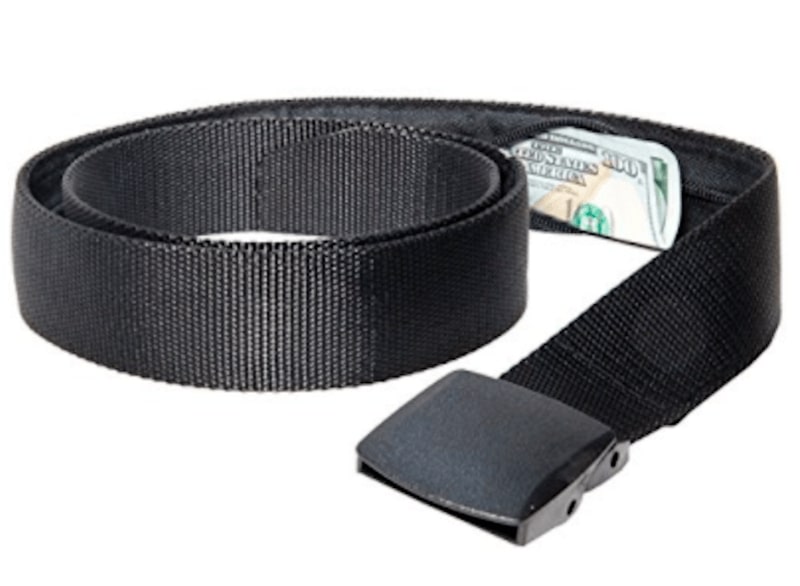
The solution to this issue is very simple: wear a money belt.
Our recommendation has definitely got to be the Active Roots Security Belt!
Not all money belts are great – but this one is. Unlike others, it simply looks and acts like a belt (instead of looking a bit obvious when you wear it under clothes).
It has a hidden zipper pocket where you can put your daily budget in cash. Simple.
No more problems with pickpockets – they won’t suspect a thing!
Is Manila safe to travel alone?

Manila is a good place for a solo travel adventure.
However, being a big city, it’s not always the most ideal place to be by yourself. Even though there are plenty of sights to see, it’s a big place where you can easily feel lonely – and unsafe.
So we’ve decided to help you out with a few of our top solo travel tips for Manila.
- Don’t be afraid to ask for help. A lot of people in the Philippines do speak and understand English – and are also friendly.
- Research the area you are staying in. Manila is a big city… Made up of other big cities. So you should choose where you are staying carefully, making sure to research the neighbourhood you plan to base yourself.
- Stay in a social hostel. Manila is a fun city, but it’s only really fun if you have people to experience it with. Make friends at a social hostel for solo travellers in Manila, so you can explore the city together.
- Read reviews. Don’t just go with a hostel that’s got 4 or 5 stars. Make sure you read actual reviews from people who’ve been there before – especially if they are solo travellers like yourself.
- Carry cash – but not too much. A lot of places in Manila are still cash-only, but don’t laden yourself down with wads of cash. Make sure you always have a stash to pay for something (money belt!).
- Don’t push yourself. You don’t have to do everything your guidebook tells you. Manila isn’t a city for everyone, so if you want to take some time out and head to airconned mall – go for it. This is the past time of many Manila-ites anyway!
- Don’t get too drunk. Especially if you are by yourself, being totally wasted can put you at risk of something bad happening to you – from getting lost to being scammed or robbed. Drink if you want, of course, but don’t go absolutely crazy.
- Ask for local advice. The staff at your hostel, a local you get chatting to – these people are going to know where is safe to explore, where you should or shouldn’t walk at night. They probably know some pretty cool cafes and restaurants, too!
- Keep in touch with people back home. If you are feeling lonely, there’s nothing like calling your best friend or your parents to touch base and keep you grounded. Having someone know where you are and what you’re doing is always safer than going off grid, too.
- Travel light. In one of the most congested cities in the world, getting around with a massive bag (or bags) is only going to be a headache – not to mention put you at risk of losing things or being a victim of crime. One bag should do!
Manila is a friendly city. It’s not always great, but if you’ve never experienced anything like this you are in for an entertaining and eye-opening time!
Locals are friendly, there are some cool scenes to discover, great nightlife, amazing malls and good food. Just explore at your own pace and you’ll be fine.
Is Manila safe for solo female travellers?

Manila may not be the top choice when it comes to picking a destination for a solo travelling destination. You would probably be thinking more along the lines of Bali or Bangkok.
But that does not mean that Manila isn’t safe for a solo female traveller – far from it! It’s a lively, energetic city that’s more than just an entry point to the Philippines.
And our tailor-made travel tips for solo female travellers in Manila will help your trip go smoothly…
- Look for a good hostel. Not only does this mean well-reviewed, but it means being approved by fellow female travellers. Ones with female-only dorms, with great, friendly staff and which offer tours and social events are will be the best for your trip.
- Choose accommodation wisely. If you don’t like hostels, and you’re going for an Airbnb, you will have to be extra careful. Make sure the neighbourhood is safe, that there are restaurants and cafes nearby, as well as public transport, eliminating the need to travel far to do things.
- Expand your social network. Meet up with other ladies travelling in Manila by checking out Facebook groups geared towards meet-ups like Host A Sister and get travel tips from other groups like Girls Like Travel. You can also search for #girlsabroad on Instagram and Twitter to find likeminded individuals.
- Sign up for a tour. This can be a fantastic way to meet up with fellow travellers and learn more about Manila. The best thing would be to use one recommended in your guidebook or research a reputable company to use.
- Dress like a local. Take cues from how other women around you are dressed and try to follow suit. You don’t have to carbon copy it, but dressing less like a tourist will lessen the chance of getting unwanted attention.
- Share your travel itinerary. Use a Google Doc, tell people over the phone, send an email – it’s safer that people know where you are instead of having no idea what you’re up to.
- Keep your phone charged. Hitting the town with 10% battery is not a good idea. Ensure it’s charged at all times and/or invest in a spare battery pack to keep your phone alive while you’re out and about.
Manila is a crazy city. It can feel overwhelming at times, but if you trust your gut, take it at your own pace and try to meet up with fellow female travellers you’ll have a great time.
Remember to thoroughly research female-friendly accommodation!
Is Manila safe to travel for families?
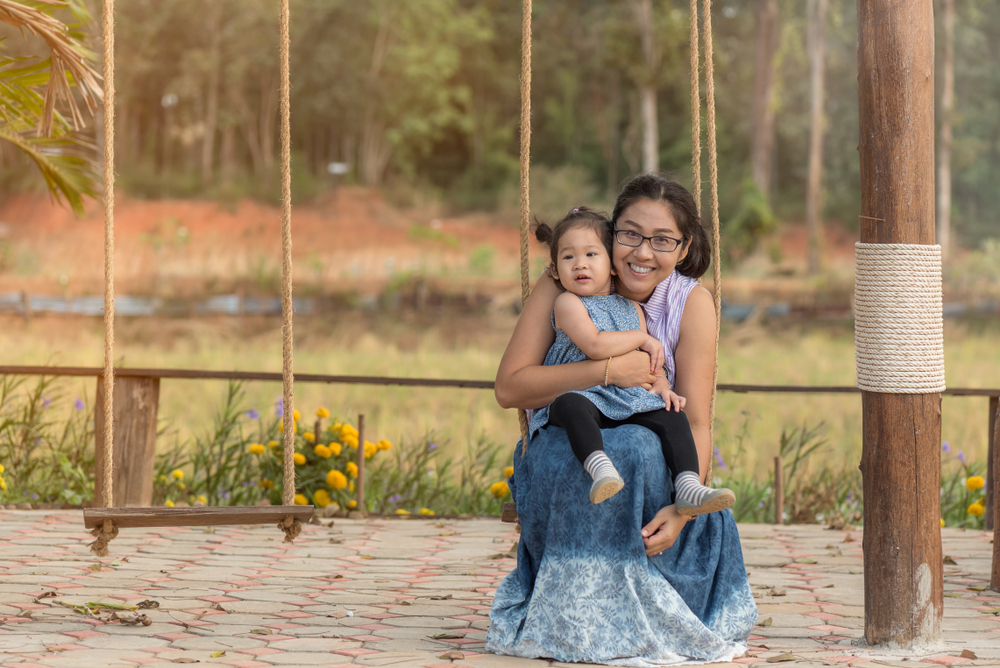
While parts of the Philippines are definitely dream family focused destinations, Manila doesn’t exactly scream “ideal spot to for a family vacation.”
That doesn’t mean that your trip to the Philippine capital can’t be a great one, though. There’s plenty of culture, warm people and a vibrant atmosphere to discover here.
If you are thinking of going, we have some tips for families travelling to Manila that’ll give you peace of mind.
- Know about the seasons. There is a dry season (December to May) and wet season (June to November). The hottest time of year is March to May when temperatures 40 degrees Celcius – or more). Make sure to know when is the best time of year to visit.
- Be aware of air pollution. If your children have respiratory problems you should consult your doctor before travelling to Manila. The air quality in this city is dire at times and can be dangerous.
- Stay at family-friendly accommodation. There’s plenty of hotels set up for families, which will give you respite away from the congested roads. Somewhere with swimming pools and childcare services should make your trip more enjoyable and carefree.
- Leave the pushchair at home. Small children are best carried in a sling or baby carrier, as pavements/sidewalks here can be uneven or just plain busy.
- Bring necessities with you. You don’t need to overpack (you can easily buy diapers here, for example, and baby formula), but bring things that you know you personally will need to make your trip run smoothly.
- Don’t expect car seats. If your children need one, you should bring your own one.
- Make the most of child friendly activities. For example, Mind Museum is an awesome science museum with interactive exhibits; Star City is an amusement park; the National Planetarium are all fun. Or join other families and take time out in Rizal Park.
- Don’t be afraid to take public transport with kids. Getting around by car can be very long, so using the LRT/MRT makes journeys around the city much quicker.
While Manila may not be the number one, ideal family destination, it can still be very fun.
With plenty of things to do, kid-friendly places to visit and malls to wander around for older children and teens – and good resort-style hotels to keep everyone happy – you’ll enjoy your trip to the Philippine capital.
Is it safe to drive in Manila?
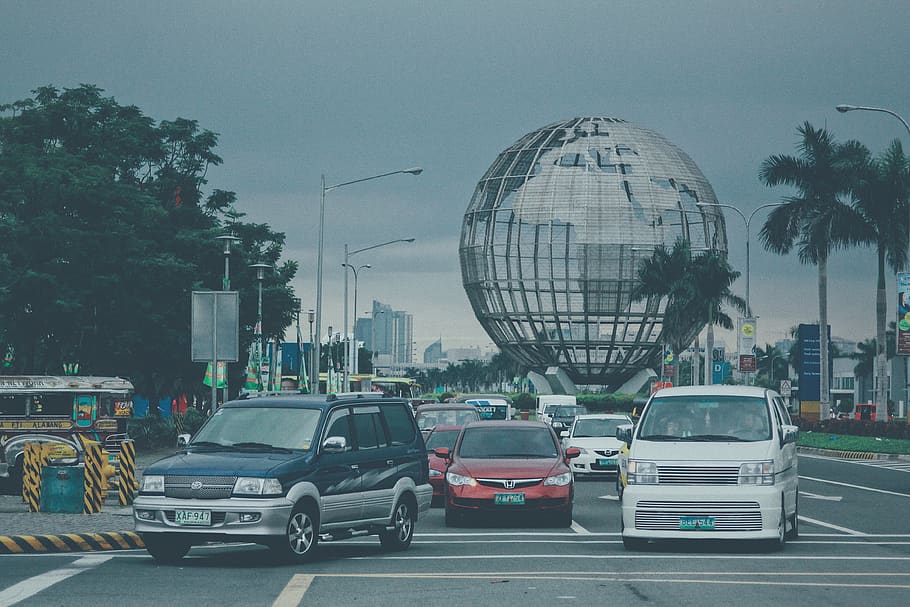 Driving in Manila is a crazy idea – and not in a good way.
Driving in Manila is a crazy idea – and not in a good way.
This is quite literally one of the most congested cities in the world, the air quality, as a result, is simply awful and driving standards are also not the best.
Nevertheless, if you want to drive – especially if you want to get out of the city (a good option) – we have a few pointers for you.
- Think about hiring a driver. You can arrange one with your accommodation. Locals will know the rules of the roads so much better than you will, and it will be a much less stressful experience.
- Pay attention to what’s going on around you. Drivers in Manila can be unpredictable; they may know the score, but you won’t and may come off worse.
- Keep an eye out for signs. These can be hidden, not obvious or just plain confusing. The roads also have markings which can be vital to getting around.
- Download Waze. Not only will this help you navigate unfamiliar roads, but also tell you what lane to drive in, and when there’s traffic or hazards up ahead. Very useful.
- Be aware of thefts from cars. Keep doors locked when in traffic; keep valuables out of view; park in a secure place.
- Your car won’t be allowed in the city on certain days. In an effort to curb congestion, Manila has a lottery scheme based on license plates that decides what cars can be in the city on which days. Check out mmda.gov.ph to learn more about this.
- Watch out for Jeepneys, buses and taxis. These don’t always follow the rules of the road (stopping suddenly, making U-turns, etc.) – colliding with one puts many people at risk.
- Keep calm. Getting stressed or angry about the state of the roads in Manila will not change anything.
Driving in Manila takes nerves of steel. You should be a calm, laid-back person who is at the same time a confident, experienced driver.
We really recommend hiring yourself a driver with a car if you want to get around. If driving yourself around is really what you want to do, then all we can say is take extra care when navigating this congested city.
Is Uber safe in Manila?
While there used to be Uber in Manila, it is no longer available.
The service now in operation, as in many Southeast Asian cities, is Grab. It is just as good as Uber and has the same benefits, i.e. no scams or hassle.
As long as you make sure that the car you’re about to step into is definitely the one you ordered through the app (check license plate, ask driver’s name, etc.) – then you should be totally fine using Grab in Manila.
The cool thing about Grab in Manila is that you don’t need wifi… You don’t even need a smartphone. There are Grab booths at the airport (Terminals 1, 2, 3 and 4).
Grab even delivers food, too!
Are taxis safe in Manila?

Taxis in Manila have a slightly bad reputation – especially among locals in Manila who know the score.
Scams and things like not putting the meter on, overcharging and not giving back correct change are rife – and can leave a bad taste in your mouth.
Ride-hailing app Grab is a favourite way among locals to get around, but if you must get a taxi here are some tips to make it safer.
- Make sure the taxi driver uses the meter. Most drivers will use the meter, but if it’s not on, ask for the driver to turn it on. If they say it’s broken, or say the fare is up to you, find another taxi.
- Get in a licensed taxi. People will sometimes come up to you and ask if you want a cab – always refuse. This isn’t how licensed cabs operate.
- Get a cab from a taxi rank. This is where you will find more reputable taxi companies and drivers. Find these outside malls, hotels and other big attractions in Manila.
- Avoid getting a cab during rush hour. They will be more expensive and take you a long time to get anywhere. Not worth it.
- Make sure you carry small change around with you. The driver could end up overcharging you if only have a large bill to pay your fare; make sure you have small change so you can pay fares exactly.
- Ask at your hotel for a recommended taxi company. They will be able to recommend a reputable company for you to use during your time in the city. They call the company up for you.
Though taxis are quite cheap, and quite plentiful, in Manila, they can also be quite annoying. Knowing the potential scams and how to pick up a good taxi is key.
Failing going it alone, asking your accommodation to help you out – or simply using Grab instead – is probably the best way to stay safe with regards to taxis in Manila.
Is public transportation in Manila safe?
 Driving yourself around Manila may not be a great idea, and taxis aren’t always the best way to get around, so that leaves you with Manila’s public transport systems.
Driving yourself around Manila may not be a great idea, and taxis aren’t always the best way to get around, so that leaves you with Manila’s public transport systems.
Covering an area of around 1,475 square kilometres, Manila is huge. Accordingly, there are a wide range of transport options to get you from A to B in the Philippine capital.
Let’s take a look at what those entail.
- Buses: Manila has a whole load of buses to think about. Local buses can be very busy with crazy drivers; they’re not usually that useful from a tourist perspective. There are, however, a handful that are good for tourists. The bus that connects Makati and The Fort, for example, and Makati with Quiapo, can be good alternatives to the MRT. Buses are one of the cheapest ways to get around Manila. Information on their routes is usually quite easy to find, English is usually spoken, but just make sure you watch out for your belongings and – for your own comfort – avoiding travelling at peak times.
- MRT/LRT: The Metro Rail Transit (MRT) and Light Rail Transit (LRT) connect the north and south of Manila. The MRT runs across Epifanio de Los Santos Avenue, whereas the LRT (lines 1 and 2) cross Pasay, Caloocan, Manila and Quezon City. Both get extremely busy during peak hours (7-9 a.m. and 5-9 p.m.) and should be avoided at these times. As with any of Manila’s public transport, watch out both on the trains and in the train stations for pickpockets; keep your belongings close to you.Tip: Get a BEEP card to get around more efficiently; charge it with cash and then simply swipe it over sensors on barriers to get access to stations.
- Jeepneys: These work like buses and are an iconic part of the Manila landscape. These are re-purposed army jeeps, almost always brightly decorated, and they run along designated routes. They aren’t very comfortable but they make for a memorable experience. Very cheap. They are being phased out, albeit slowly, so it may be now or never. Check out sakay.ph which will help you out with Jeepneys (and more).
- FX and UV Express: The modern form of a Jeepney, these are air-conned, white vans named after their brands – the Toyota UV Express and the Tamaraw FX. They cruise along routes similar to those used by Jeepneys, the only difference being they are more comfortable, less rickety, and pretty safe. Straightforward to use.
- Tricycle: Manila’s answer to Bangkok’s tuk-tuk, tricycles ply the roads around the city and are surprisingly popular. Running along pre-set routes, they take a handful of passengers but can sometimes be used as a taxi. Not the safest, or it doesn’t feel the safest, of Manila’s public transport but they are quick and cheap.
- Ferries: The Pasig River Ferry connects Intramuros and Makati. It may not be the quickest way to get around, but the ferry does pass by some pretty interesting spots from a tourist point of view. It’s safe, pretty reliable and easy to use to boot.
There are many ways to get around Manila. What methods you use depend on where you want to go, what experience you want, and how much money you have.
To get all the information you need, head over to sakay.ph. Otherwise just watch your belongings, stay aware of your surroundings and enjoy getting around Manila like a local!
Is the food in Manila safe?
 Manila is a modern day metropolis filled with an abundance of places to eat.
Manila is a modern day metropolis filled with an abundance of places to eat.
Food in the Philippines may not have a great reputation, but there are plenty of joints you can eat at in the capital where you can get a delicious meal.
From street food and local eateries, to high-end restaurants and hipster cafes rising up, there’s a good local food scene going on in Manila.
Don’t let the haters dissuade you from this tasty cuisine… But do keep our tips for eating out in Manila in mind.
- Don’t be afraid of street food. It may look scary, but it’s really not. Research on what local specialities you want to try, what parts of the city are famous for different types of cuisine, and what particular eateries are tried-and-tested is key.
- Follow the locals. They will know where the best places to eat are. If you pass by somewhere that’s busy with locals, then chances are it is probably very tasty.
- Ease yourself in. Food is an integral part of the culture here, but you may not be used to all the ingredients, spices and flavours involved. A sudden change in diet is a common reason for an upset stomach, so go easy on it at first.
- Don’t feel you only have to eat Philippine food. There’s a mixture of cultures at work in Manila that means you won’t have to stick to any nationality of food. From sushi restaurants and Western chains, to Chinese restaurants and local fast food joints like Jollibees, there’s loads to choose from.
- Opt for food that’s been cooked fresh in front of you. If you can verify that something has been cooked at a high heat right before your very eyes, then it’s probably going to be safe to eat.
- Head to food courts. A happy medium between hotel buffet and local eatery, food courts are where it’s at in Manila. There will be a dozen or so different choices, all usually pretty clean and up to food safety standards.
- Wash your hands. Spending time exploring any city in the world means you’re going to end up with dirty hands – simple as that! Washing your hands will save germs and bacteria you pick up from the city ending up on your food as you eat it. If hand washing facilities are unavailable, bringing hand sanitiser is a good idea.
- Bring anti-diarrhoea medication. This may seem extreme, but just in case you do pick up a case of food poisoning, this will be crucial to recovering. Rehydration sachets also work wonders!
Manila could seem like a daunting place to find a bite to eat. Doing some research will really open up the city to you, but if you are worried… Get a guide and go on a food tour! It will give you a good grounding to explore the capital’s food scene for yourself.
Other than that… Enjoy!
Can you drink the water in Manila?
The tapwater in Manila is generally fine – depending on the quality of where you are staying.
Though it is cleaned and up to WHO standards, not all places in the city have the same pipes or even access to the same water.
Hotels will most likely have safe drinking water. When you’re out and about, it’s best to err on the side of caution and avoid drinking tap water from other establishments.
We recommend that you bring a refillable water bottle and fill up from your hotel before you head out. Buying endless bottled water is not cool!
Is Manila safe to live?
 Manila is an exciting city. It’s big, it’s loud and there’s tons to do. It is a popular spot for foreigners to the country to live, and many do live there – especially for business… But it’s not for everybody.
Manila is an exciting city. It’s big, it’s loud and there’s tons to do. It is a popular spot for foreigners to the country to live, and many do live there – especially for business… But it’s not for everybody.
It is exciting, but it could be scary. It’s big – but maybe too big. It is congested and it can feel like there are too many people in one space at times.
Aside from adapting to general city life (depending on where you come from), you will have to bear the following points in mind.
- Petty crime exists here not just for tourists, but is part of everyday life that you need to be aware of. As a Western person, you may be more of a target than a local, even though you’re not a tourist.
- Traffic here in Manila is some of the worst in the world. Even if you live in a swanky apartment in a gated community, you will still have to deal with the traffic – and may be stuck in it for a few hours daily on your commute to work.
- Air pollution is something you may not be used to. All that traffic results in terrible air quality. Some days are worse than others. You may want to buy facemasks regularly, check the news for bad days (when you should work from home, perhaps) and if you have asthma, or another respiratory problem, you should talk to your doctor about bad air quality before you move to Manila. It affects 98% of the city’s population.
- Pollution, in general, is a big issue. The Pasig River, for example, is one of the world’s most polluted rivers (according to the Asian Development Bank), with tons of domestic and industrial waste simply dumped into it every day. Seeing the level of pollution on a daily basis could get some people down, so being able to not be sensitive to these things may be a plus.
- Poverty is also an issue. There are vast disparities between rich and poor, meaning an unfair situation for much of the population. It’s important to know about the socio-economic issues of Manila if you are planning on living there longterm.
- And then there are natural disasters. In 2009, for instance, the Philippines had the third highest number of casualties from natural disasters in the world. Earthquakes, volcanic eruptions, tsunamis, tropical storms and typhoons can be genuine risks to your safety.
In conclusion – as with most things – research is the key!
Talk to other expats in Manila; ask where they live and what areas are good to live in. Visit the city for yourself and see what neighbourhoods feel right for you. Make sure you know the political, environmental and social issues of the city.
Be prepared for an adventure in a never-sleeping city filled with friendly people!
How is healthcare in Manila?
Manila’s healthcare is actually surprisingly comprehensive.
Private healthcare is especially good, with Manila being a popular spot for medical tourism!
- The city’s healthcare facilities are used to treating foreign patients; they treat around a quarter of a million foreigners every year!
- Manila has modern hospitals and the healthcare is competent and affordable. You shouldn’t have any trouble getting the appropriate care you need.
- Philippine pharmacies are a good first port of call for minor ailments. Here you can pick up basic things like bandages, painkillers and also ask for information from the pharmacist themselves – often they will be able to speak good English and point you in the direction of a doctor.
- Medical travel insurance is something you really need to travel with. Both for public and private healthcare.
- The public healthcare system, which has undergone reforms in recent years, is good, but sometimes may not fully resemble what you expect of a modern medical facility. They just aren’t as good as private hospitals and clinics.
- When it doubt, it is a good idea to ask at your accommodation for recommended doctors’ clinics and hospitals where you can be looked at.
- Doctors’ clinics require no appointments; simply walk in, wait your turn and you’ll often be seen within an hour.
- If you need emergency care, simply call 911 and ask for an ambulance.
The healthcare in Manila is generally of a good quality – you shouldn’t face any barriers in terms of language, cleanliness or quality.
The main thing is to ensure that you are covered by your travel insurance!
Final thoughts on the safety of Manila
 At the end of the day, Manila is a big city. Urban areas throughout the world are always more dangerous than their rural counterparts, with theft and crime, in general, being an issue.
At the end of the day, Manila is a big city. Urban areas throughout the world are always more dangerous than their rural counterparts, with theft and crime, in general, being an issue.
Manila has extra issues from pollution and the natural world… But it’s a safe city to explore. It’s fun, too. Just make sure you do your research and be aware of your surroundings.
Don’t do anything you wouldn’t do in your home country!
And whatever you do, do not travel without insurance!






